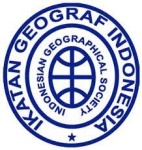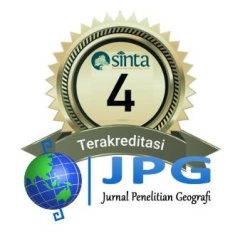Spatial Variability of Land Use Changes Due to JJLS (Southern Cross Road Network) Development in Kulon Progo Regency in 2016, 2020, and 2024
Abstract
The construction of the JJLS (Southern Cross Road Network) project in Kulon Progo Regency passes through Kapanewon Galur, Panjatan, Wates, and Temon to connect the Provinces of DIY and Central Java. The development of JJLS infrastructure can lead to the development of residential land and other functional buildings in the surrounding areas (Hendry, 2021). This study attempts to determine changes in land use variability due to the construction of JJLS in Kulon Progo Regency. Based on this information, changes in land use that occur intensively in certain areas can be monitored and detected early, so that appropriate policies can be formulated to prevent uncontrolled changes in land use. The research method used in this study is the interpretation of digital sentinel 2 imagery, which is then overlayed with a land use map to determine land changes that occurred in 2016, 2020 and 2024. Statistical analysis was carried out to determine the effect of JJLS development on land use changes in Kulon Progo Regency, especially in the sub-districts through which JJLS passes. The results of the study showed that there were significant changes in land use in the range of 2016, 2020 and 2024. Based on the results of the RCI calculation in 2016 to 2020, the lowest RCI value was 0,2917 and the highest value was 3,156. While the RCI value for 2020 to 2024 had the lowest value of 0.3862 and the highest was 2,1791. Based on the RCI value, it is divided into 3 classes, low, medium, and high, in order to represent the intensity of change in each village. Based on the results of statistical calculations, it can be concluded that there is a strong influence between the JJLS variable and the growth of built-up land in the research area.
References
Aburas, M. M., Ho, Y. M., Ramli, M. F., & Ash’aari, Z. H. (2017). Improving the capability of an integrated CA-Markov model to simulate spatio-temporal urban growth trends using an Analytical Hierarchy Process and Frequency Ratio. International Journal of Applied Earth Observation and Geoinformation, 59, 65-78. https://doi.org/10.1016/j.jag.2017.03.006
Ahasan, R., & Güneralp, B. (2022). Transportation in urban land change models: a systematic review and future directions. Journal of Land Use Science, 17(1), 351–367. https://doi.org/10.1080/1747423X.2022.2086639
Arfa, A., & Minaei, M. (2024). Utilizing multitemporal indices and spectral bands of Sentinel-2 to enhance land use and land cover classification with random forest and support vector machine. Advances in Space Research, 74(11), 5580-5590.
https://doi.org/10.1016/j.asr.2024.08.062
Badan Standarisasi Nasional. (2014). Klasifikasi penutup lahan – Bagian 1: Skala kecil dan menengah. Diakses 22 Maret 2023, dari https://www.bsn.go.id
Bintoro, A. Y. (2008). Pengaruh ruas jalan arteri Soekarno - Hatta terhadap fisik kawasan di sekitarnya (Tesis Magister, Universitas Diponegoro). Universitas Diponegoro.
Buğday, E., & Buğday, S. E. (2019). Modeling and simulating land use/cover change using artificial neural network from remotely sensing data. Cerne, 25, 246-254. https://doi.org/10.1590/01047760201925022634
Cao, Y., Zhang, X., Fu, Y., Lu, Z., & Shen, X. (2020). Urban spatial growth modeling using logistic regression and cellular automata: A case study of Hangzhou. Ecological indicators, 113, 106200. https://doi.org/10.1016/j.ecolind.2020.106200
Chadchan, J., & Shankar, R. (2012). An analysis of urban growth trends in the post-economic reforms period in India. International Journal of Sustainable Built Environment, 1(1), 36-49. https://doi.org/10.1016/j.ijsbe.2012.05.001
Dehghani, A., Soltani, A., & Nateghi, K. (2025). Balancing Urban Growth and Environmental Change: Land Use Patterns in Tehran and Sydney. Environmental and Sustainability Indicators, 100691. https://doi.org/10.1016/j.indic.2025.100691
Dinda, R., Mariati, H., & Fitriawan, D. (2022). Analisis Proyeksi Penduduk dan Alokasi Kebutuhan Lahan Permukiman Di Kota Padang 2020-2030. Jurnal Azimut, 4(1), 19-27. https://doi.org/10.31317/jaz.v4i1.790
Edy, H., & Tantin, P. (2021). Dampak pembangunan Jalur Jalan Lintas Selatan (JJLS) terhadap perubahan penggunaan lahan. Jurnal Media Komunikasi Dunia Ilmu Sipil (MoDuluS), 3(1), 7–11. https://doi.org/10.32585/modulus.v3i1.1770
European Space Agency (ESA). (2015). Sentinel-2 user handbook (2nd ed.). ESA Standard Document. https://sentinel.esa.int/documents/247904/685211/Sentinel-2_User_Handbook
Ghent, C. (2018). Mitigating the effects of transport infrastructure development on ecosystems. Consilience, (19), 58-68. https://www.jstor.org/stable/26427712
Girsang, S. S. B., Banurea, D. M., Lestari, P., Nambela, J. B., Verawaty, I., Barus, J., ... & Purba, T. (2025). Dynamics prediction of land use changes using cellular automata and artificial neural network modeling. Global Journal of Environmental Science and Management, 11(2), 427-442. https://doi.org/10.22034/gjesm.2025.02.04
Giyarsih, S. R. (2010). Pola Spasial Transformasi Wilayah di Koridor Yogyakarta-Surakarta. Forum Geografi, 24(1), 28. http://dx.doi.org/10.23917/forgeo.v24i1.5013
Hakim Sinaga, S., Suprayogi, A., & Haniah. (2018). Analisis Ketersediaan Ruang Terbuka Hijau Dengan Metode Normalized Difference Vegetation Index Dan Soil Adjusted Vegetation Index Menggunakan Citra Satelit Sentinel 2A (Studi Kasus : Kabupaten Demak). Jurnal Geodesi Undip Januari, 7(1). https://doi.org/10.14710/jgundip.2017.19329
Handayani, H. H., Murayama, Y., Ranagalage, M., Liu, F., & Dissanayake, D. (2018). Geospatial Analysis of Horizontal and Vertical Urban Expansion Using Multi-Spatial Resolution Data: A Case Study of Surabaya, Indonesia. Remote Sensing, 10(10), 1599. https://doi.org/10.3390/rs10101599.
Indriana, I., & Nando, J. (2024). Drone Multispektral Dalam Pemetaan Tutupan Lahan Kajai, Pasaman Barat, Sumatera Barat, Indonesia. Jurnal Penelitian Geografi (JPG), 12(1), 73-79. https://doi.org/10.23960/jpg.v12i1.29638
Lillesand, T. M., Kiefer, R. W., & Chipman, J. W. (2015). Remote Sensing and Image Interpretation (7th ed.). New York: John Wiley & Sons, Inc.
Muhammad, R., Zhang, W., Abbas, Z., Guo, F., & Gwiazdzinski, L. (2022). Spatiotemporal change analysis and prediction of future land use and land cover changes using QGIS MOLUSCE plugin and remote sensing big data: A case study of Linyi, China. Land, 11(3), 419. https://doi.org/10.3390/land11030419
Pamungkas, B. (2023). Pemanfaatan geoinformatik untuk analisis perubahan penggunaan lahan dan risiko tsunami di sebagian pesisir Kabupaten Kebumen (Tesis Magister, Universitas Gadjah Mada). Universitas Gadjah Mada.
Paramitha, B. A. P. (2011). Model cellular automata untuk prediksi perkembangan wilayah menggunakan citra penginderaan jauh resolusi menengah (Studi kasus wilayah Kedungsepur) (Tesis Magister, Fakultas Geografi, Universitas Gadjah Mada). Universitas Gadjah Mada.
Pemerintah Daerah Daerah Istimewa Yogyakarta. (2016). Surat Keputusan Gubernur DIY Nomor 118/KEP/2016 tentang Penetapan Ruas Jalan Provinsi. Yogyakarta: Pemerintah Provinsi DIY.
Pemerintah Indonesia. (2021). Peraturan Pemerintah Republik Indonesia Nomor 21 Tahun 2021 tentang Penyelenggaraan Penataan Ruang.
Phiri, D., Simwanda, M., Salekin, S., Nyirenda, V. R., Murayama, Y., & Ranagalage, M. (2020). Sentinel-2 Data for Land Cover/Use Mapping: A Review. Remote Sensing, 12(14), 2291. https://doi.org/10.3390/rs12142291
Pratiwi, S. E. (2018). Pemodelan spasial harga lahan dan perubahannya akibat pembangunan Bandara New Yogyakarta International Airport di sekitar area bandara (Skripsi Sarjana, Universitas Gadjah Mada). Universitas Gadjah Mada.
Pratomoatmojo, N. A. (2014). Landusesim sebagai aplikasi pemodelan dan simulasi spasial perubahan penggunaan lahan berbasis Sistem Informasi Geografis dalam konteks perencanaan wilayah dan kota. Seminar Nasional Cities, 69–80. http://dx.doi.org/10.12962%2Fj2716179X.v13i1.7064
Pravitasari, A. E., Rustiadi, E., Priatama, R. A., Murtadho, A., Kurnia, A. A., Mulya, S. P., Saizen, I., Widodo, C. E., & Wulandari, S. (2021). Spatiotemporal Distribution Patterns and Local Driving Factors of Regional Development in Java. ISPRS International Journal of Geo-Information, 10(12), 812. https://doi.org/10.3390/ijgi10120812
Pusat Teknologi dan Data Penginderaan Jauh LAPAN. (2015). Pedoman pengolahan data satelit multispektral secara digital supervised untuk klasifikasi. Lembaga Penerbangan dan Antariksa Nasional (LAPAN).
Putri, S. H. (2024). Analisis proyeksi kebutuhan dan daya dukung lahan permukiman terhadap RTRW Kabupaten Kulon Progo tahun 2012–2032 (Skripsi Sarjana, Fakultas Geografi, Universitas Gadjah Mada). Universitas Gadjah Mada.
Ramadhan, A. H. (2019). Analisis digital citra Landsat untuk identifikasi perkembangan lahan terbangun akibat pengembangan Jalur Jalan Lintas Selatan Jawa di sebagian Provinsi Jawa Tengah dan Daerah Istimewa Yogyakarta (Skripsi Sarjana, Fakultas Geografi, Universitas Gadjah Mada). Universitas Gadjah Mada.
Richards, J.A. (2022). Supervised Classification Techniques. In: Remote Sensing Digital Image Analysis. Springer, Cham. https://doi.org/10.1007/978-3-030-82327-6_8
Rwanga, S. S., & Ndambuki, J. M. (2017). Accuracy assessment of land use/land cover classification using remote sensing and GIS. International Journal of Geosciences, 8(04), 611. https://doi.org/10.4236/ijg.2017.84033
Salim, W., & Faoziyah, U. (2022). The effect of transport infrastructure on land-use change: The case of toll road and high-speed railway development in West Java. J. Reg. City Plan, 33(1), 48-65. https://doi.org/10.5614/jpwk.2022.33.1.3
Santoso, A. B. (2018). Tutorial & solusi pengolahan data regresi. Agung Budi Santoso.
Saputra, D. M. A. (2023). Pemanfaatan Citra Landsat 8 untuk Pemetaan Perubahan Penggunaan Lahan di Daerah Terdampak Erupsi Gunungapi Semeru (4 Desember 2021). Jurnal Penelitian Geografi (JPG), 11(1), 1-10. http://dx.doi.org/10.23960/jpg.v11i1.1-10
Sarun, S., Vineetha, P., Kumar, R., & Jayalekshmi, V. (2018). Spatial Analysis of Land Use and Land Cover Changes Using Spectral Indices in the Tsunami Affected Areas in Kerala, India. Journal of Geography, Environment and Earth Science International, https://doi.org/ 10.9734/jgeesi/2018/41927 15(4), 1–11.
Sudjana, L., Sodikin, S., & Astarika, R. (2024). Spatiotemporal Dynamics of Mangrove Cover Change in Tanjungpinang City, Riau Islands Province. Jurnal Penelitian Geografi (JPG), 12(2), 167-184. https://dx.doi.org/10.31028/jpg
Surya, B., Ahmad, D. N. A., Sakti, H. H., & Sahban, H. (2020). Land Use Change, Spatial Interaction, and Sustainable Development in the Metropolitan Urban Areas, South Sulawesi Province, Indonesia. Land, 9(3), 95. https://doi.org/10.3390/land9030095
Susilo, B. (2016). Map analysis and spatial statistic: Assessment of spatial variability of agriculture land conversion in urban fringe area of Yogyakarta (Laporan penelitian, Fakultas Geografi, Universitas Gadjah Mada). Universitas Gadjah Mada.
Tang, Z.; Wang, Y.; Fu, M.; Xue, J., (2023). The role of land use landscape patterns in the carbon emission reduction: Empirical evidence from China, Ecological Indicators, Vol. 156, 111176. https://doi.org/10.1016/j.ecolind.2023.111176
Tilova, U. D. N., Mardiatno, D., & Marfai, M. A. (2024). Transgresi dan Regresi Garis Pantai dari Tahun 2014-2023 dengan Menggunakan DSAS di Wilayah Kepesisiran Kabupaten Kulon Progo Yogyakarta. Jurnal Penelitian Geografi (JPG), 12(1), 38-46. http://dx.doi.org/10.23960/jpg.v12.i1.28562
Wang, S., Wang, J., and Liu, X. (2019). How Do Urban Spatial Structures Evolution in the High-Speed Rail Era? Case Study of Yangtze River Delta, China. Habitat Int. 93, 102051. https://doi.org/10.1016/j.habitatint.2019.102051
Yan, X., Liu, Y., Sun, H., Li, J., & Yang, H. (2024). Spatiotemporal impacts of metro network structure on land use change. Journal of Urban Management, 13(2), 183-200. https://doi.org/10.1016/j.jum.2024.04.002
Yunus, H. S. (2000). Struktur tata ruang kota. Yogyakarta: Pustaka Pelajar.
Zhou, L., Dang, X., Sun, Q., & Wang, S. (2020). Multi-scenario simulation of urban land change in Shanghai by random forest and CA-Markov model. Sustainable Cities and Society, 55, 102045. https://doi.org/10.1016/j.scs.2020.102045
Refbacks
- There are currently no refbacks.
INDEX JOURNAL


















